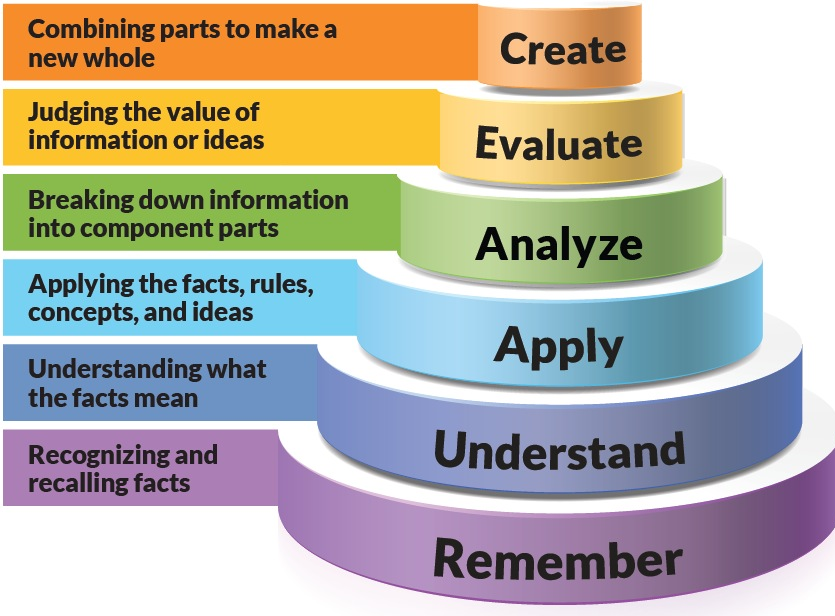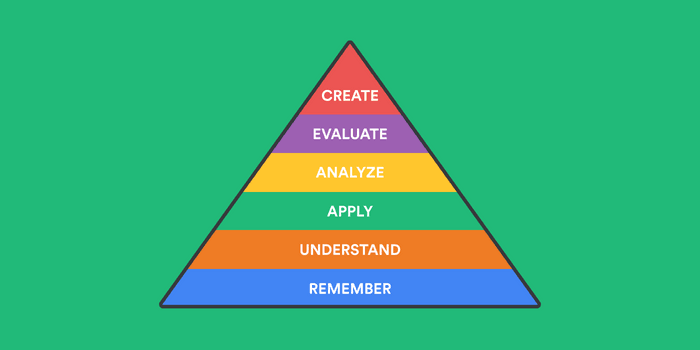Teaching comes with a great responsibility and has the power to empower students and self. it is just not instruction but a meaningful delivery of the subject matter. Many teachers across the globe have been putting in their best efforts for the desired outcomes.
The framing of syllabus is processed through the teacher and handed over to students and this can be done even more effectively by supplementing one’s knowledge with educational theories propounded by education researchers.
Bloom’s Taxonomy is named after Benjamin Bloom, an educational psychologist. His project, which he undertook in 1956, involved classifying the levels of behavior It is a hierarchical model to classify educational learning objectives.

Using Bloom’s Taxonomy, encourages higher-order thinking skills in students. It takes them up from lower-level cognitive skills. The behavioural and learning outcomes, thus attained can be incorporated educational goals. Let’s look at an elaboration:
- Remembering: Retrieving, recognizing, and recalling relevant knowledge from long‐term memory.
- Understanding: Constructing meaning from oral, written, and graphic messages through interpreting, exemplifying, classifying, summarizing, inferring, comparing, and explaining.
- Applying: Carrying out or using a procedure for executing, or implementing.
- Analysing: Breaking material into constituent parts, determining how the parts relate to one another and to an overall structure or purpose through differentiating, organizing, and attributing.
- Evaluating: Making judgments based on criteria and standards through checking and critiquing.
- Creating: Putting elements together to form a coherent or functional whole; reorganizing elements into a new pattern or structure through generating, planning, or producing.
Teachers can use the model by selecting topics from their respective subjects. The lesson level objectives can be achieved which will finally contribute to the course level objectives. Analysis, synthesis and evaluation play an important role. The model also aids teachers in testing and in giving assignments to students.
Each in the taxonomy is associated with a verb keeping in mind that ‘learning’ as such is an action. When teachers, ask questions in the class and in tests or assignments, they should consider the different phases of the Bloom’s pyramid.
Remembering and understanding help form questions for objective type of tests like ‘Multiple Choice’, ‘Fill in the blanks’ and ‘Match the Following’. Essay type questions, experiments and performances are part of subjective assessment take into consideration applying, analysing, evaluating and creating. By Starting with the lowest level of the rung, the incorporation of the highest levels can be taken up as the unit progresses.
- Remembering- words like- define, Who, What, List, Label, Name, Match, Select and underline may be used
- This level’s focus is on how much the students have understood the topic and its main idea. They should also be able to interpret and summarize it. So, the words used in the questions are- Interpret, Explain, Summarize, Elaborate, Outline, Discuss, Restate, Translate, Describe, ‘Do you agree or not’-Support your answer…’
- In the third level of ‘applying’, the students should be able to apply what they have studied. They should be able to demonstrate, present, change or modify to solve problems or create projects. The words that appear in the questions are- Use (example: laws/ theorems etc.) Predict, Construct (something that bases itself on what they have learnt), Perform (could be getting into a role of a particular play, or a role -play), Demonstrate (an experiment), Classify and Apply.
- The fourth is ‘analyzing’. The words in the questions are- Analyze, hat are the ideas, inferences you draw from—–?), Explain, Identify, and Examine.
- The fifth level focuses on ‘evaluating. Students, come up with their opinions and ideas through evaluation and analysis. It includes assessment, verification and prioritization. So, the words that the questions are: Evaluate, Analyze, write your opinion …., Decide, Select, Debate, Judge and Justify.
- In the sixth level of ‘creating’, students move on with the previous instruction and try to go beyond it. They come with new ideas, and innovative projects for products. The focus is on alternatives, generations, changes and inventions. The questions that emerge use the words- Create (could also be a poem), Propose, compose, propose, plan (planning an event for fundraising or planning a student conference), Design (could be a model or a project which campaigns against a social evil) and develop.
Thus, Bloom’s taxonomy helps many a teacher to enrich their teaching and his/her students.









